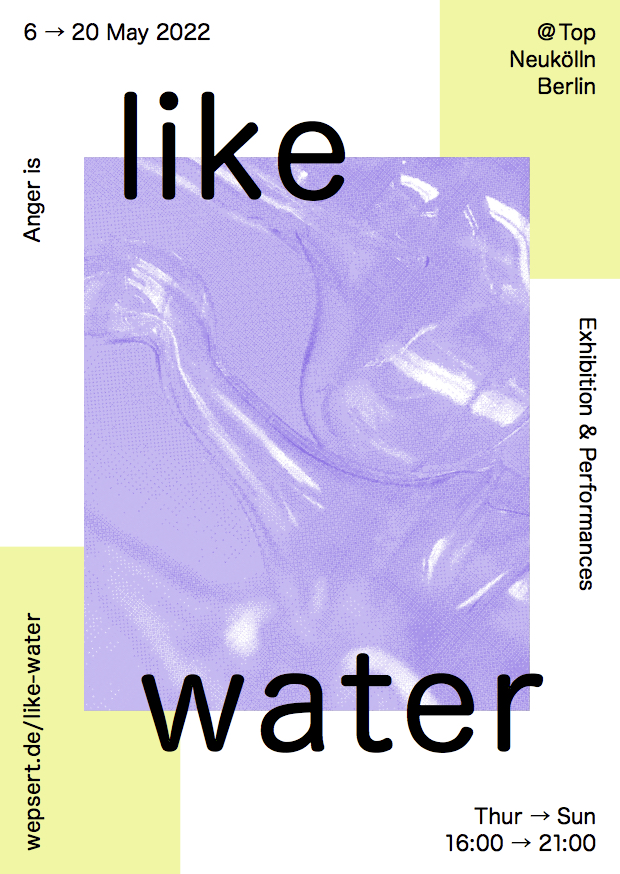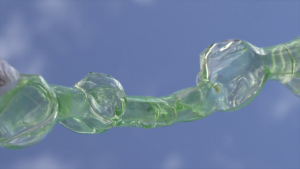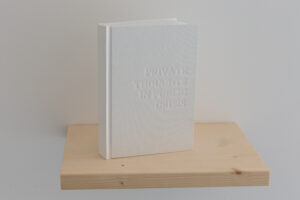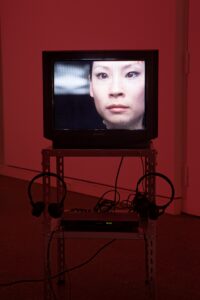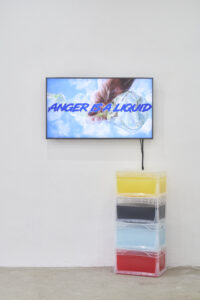Group exhibition & Performances
Exhibition on view: 06.05.22 – 20.05.22
Visiting hours: Thursday – Sunday, 16:00 – 21:00
Soft Opening: 06.05.22, Friday, 18:00 with a Performance by Lux Venérea
TOP project space, Schillerpromenade 4, 12049 Berlin
Performance
14.05.2022, Saturday, 18:00
Mariama Nzinga Diallo & Vivian Crespo Zurita
Reading & Talk
19.05.2022, Thursday, 19:30
Adelaide Ivánova, Sarah Berger
Finissage: 20.05.2022, Friday, 18:00 with Performances by Birte Opitz and Lotti Seebeck
Participating artists:
Christa Joo Hyun D’Angelo, Lilian Robl, Marleen Rothaus, Ivana Pavlíčková, Đejmi Hadrović, Cleo Kempe Towers, Lux Venérea, Vivian Crespo Zurita, Mariama Nzinga Diallo, Birte Opitz and Lotti Seebeck
The group exhibition Like Water explores the complex relationship between rage and femininity from diverse angles and through different artistic media, explicitly taking femininities outside of a binary gender system into account as well.
Anger is a multi-layered emotion. It can be destructive and transformative, rational and impulsive, empathetic and isolating. In its ability to point the finger at injustice and reinforce boundaries, it’s one of the most powerful emotional tools we have.
Historically and societally, few emotions are gendered as much as anger. Gender does not only affect the way anger is treated and coped with individually, but also the extent to which people are able to use its potential. It is primarily women, non-binary and trans people whose anger is not heard. Other forms of discrimination reinforce this. But just because this anger often remains invisible, it does not disappear. The title Like Water refers to a quote by the writer and activist Soraya Chemaly, who writes in her book Rage Becomes Her. The Power of Women’s Anger „Anger is like water. No matter how hard you try to contain it, channel it or deny its existence, it always finds a way, and usually the way of least resistance.“
So where to put that anger and how?
Like Water lets various artists take a stand on the topic. Sometimes serious, sometimes playful, painting, ceramics, video, installation and live performances serve as a means to illuminate female rage and its underlying structures, histories, aesthetics and potentials. The works on view invite visitors to engage with the questions raised and their own emotions.
Lilian Robl‘s video installation Anger is a Liquid addresses the suppression and personal handling of anger in female socialized bodies from historical, sociological and psychological perspectives. Đejmi Hadrović‘s Private Thoughts in Public Crisis highlights the revolutionary potential of private (angry) thoughts. A book of short sarcastic statements on world events is continued by a QR code that invites the audience to share their own thoughts on political and social ills publicly and anonymously. Marleen Rothaus‘ shows When Mary Got Mad and Care, Rage, two new works at the intersection of art and political activism: Paintings based on depictions of Mary as well as photographs of activists during 8th March demonstrations are transformed into banners for feminist protest actions. Christa Joo Hyun D‘Angelo‘s video collage Cool Girl plays with racialised representations of female characters in popular culture and confronts the viewer with the threatening and restrictive ways in which BIWoC* are exoticised and caricatured. Ivana Pavlíčková‘s installation Rage techniques consists of five small-format ceramic sculptures and deals with various forms of ex- and internalized protest. Cleo Kempe Towers‘ work Life is Fun and Fulfilling explores passive aggression as a survival strategy. The only interface with the audience is their hands, which protrude from an installation of fabrics, inviting the viewers to get closer.
The group exhibition is complemented by a performance and reading programme taking place over three days.
Performer, chef and comedian Lux Venérea will kick off the opening with a stand-up monologue. Using ironic elements from pop and meme culture, she focuses on the gaze of the dominant society and questions normalized forms of social stigmatization and othering. Mein traumatisierter Körper ruft nach Befreiung (My Traumatised Body Calls for Liberation) by Mariama Nzinga Diallo and Vivian Crespo Zurita deals with intergenerational trauma through references to the Berlin Conference organized by Otto von Bismarck, which formed the basis for the European colonization of the African continent. Author, photographer and performance artist Sarah Berger will read from a collection of social media collages titled Lesen und Schreien (Reading and Screaming), poetically mapping the layers of our existence in the digital. Adelaide Ivánova is a poet and activist. Her poetry collection The Hammer is both a weapon and a tool, an outcry against millennia of rape and a serious attempt to imagine otherwise. Both Lotti Seebeck and Birte Opitz use the outdoor space in front of TOP for their works; their performances focus on the actual embodiment of rage. Seebeck‘s performative training series Wütende Entropie (Angry Entropy) investigates the extent to which emotional states are consciously emphasized and altered by actively and passively influencing body temperature. Opitz‘s performance, on the other hand, is based on somatic dance and voice improvisations as well as methods from self-assertion and explores the transformative and empowering potential of anger.
The exhibition is initiated by Wepsert e.V. (feminist online magazine and non-profit association for the promotion of women and non-binary people in culture and literature; www.wepsert.de) in cooperation with Alisha Gamisch (author and board member of Wepsert e.V.), Jaana Heine (art scholar and exhibition producer), Lia Kastiyo-Spinósa (artist and editor at Migrazine) and Migrazine (Online Magazine by Migrant:innen for Everyone; www.migrazine.at).
Like Water is funded by Stiftung Kunstfonds, Bonn as well as Bezirksamt Neukölln – Fachbereich Kultur and is also realized with the support of Stiftung wissensART, Berlin.
________________
Ausstellung & Performances
geöffnet: 06.05.2022 – 20.05.2022
Donnerstag – Sonntag, 16:00 – 21:00 Uhr
Vernissage: 06.05.2022, Freitag ab 18:00 Uhr mit einer Performance von Lux Venérea
TOP, Schillerpromenade 4, 12049 Berlin
Performance & Lesung
14.05.2022, Samstag ab 18:00 Uhr
Mariama Nzinga Diallo & Vivian Crespo Zurita
Lesung & Gespräch
19.05.2022, Donnerstag, 19:30 Uhr
Adelaide Ivánova, Sarah Berger
Finissage: 20.05.2022, Freitag ab 18:00 Uhr mit Performances von Birte Opitz und Lotti Seebeck
Teilnehmende Künstler/innen: Christa Joo Hyun D’Angelo, Lilian Robl, Marleen Rothaus, Ivana Pavlícková, Đejmi Hadrović, Cleo Kempe Towers, Lux Venérea, Vivian Crespo Zurita, Mariama Nzinga Diallo, Birte Opitz und Lotti Seebeck
Die Gruppenausstellung Like Water setzt sich aus unterschiedlichen Blickwinkeln und anhand verschiedener künstlerischer Medien mit dem komplexen Verhältnis von Wut und Weiblichkeit auseinander. Dabei geht es explizit auch um Weiblichkeiten außerhalb eines binären Geschlechtersystems.
Wut ist vielschichtig. Sie kann destruktiv und transformativ sein, rational und impulsiv, empathisch und isolierend. In ihrer Fähigkeit, auf Missstände aufmerksam zu machen und persönliche Grenzen aufzuzeigen, ist sie eines der mächtigsten emotionalen und politischen Werkzeuge überhaupt.
Wenige Gefühle sind historisch und gesellschaftlich so stark gegendert wie die Wut. Dabei beeinflusst Gender nicht nur den persönlichen Umgang mit Wut, sondern auch die Möglichkeit, ihr Potential zu nutzen. Es sind vor allem Frauen sowie nicht-binäre und trans Personen, deren Wut nicht gehört wird. Andere Diskriminierungsformen verstärken dieses Nichtgehörtwerden. Doch nur, weil diese Wut oft unsichtbar bleibt, verschwindet sie nicht: Der Titel Like Water verweist auf ein Zitat der Schriftstellerin und Aktivistin Soraya Chemaly, die in ihrem Buch Speak out! Die Kraft weiblicher Wut schreibt: „Wut ist wie Wasser. Wie sehr man auch versucht, sie einzudämmen, zu kanalisieren oder ihr Vorhandensein zu leugnen: Sie findet immer einen Weg, und zwar im Normalfall den des geringsten Widerstands.“
Wohin also mit der Wut und wie?
Like Water lässt verschiedene Künstler*innen zum Thema Stellung beziehen. Mal ernst, mal spielerisch dienen Malerei, Keramik, Videoarbeiten, Installationen und Live-Performances als Mittel; weibliche Wut sowie die ihr zugrunde liegenden Strukturen, Geschichten, Ästhetiken und Potentiale zu beleuchten. Die präsentierten Arbeiten laden die Besucher*innen zur Auseinandersetzung mit den aufgeworfenen Fragestellungen und ihren eigenen Emotionen ein.
So thematisiert Lilian Robls Videoinstallation Anger is a Liquid die Unterdrückung von und den persönlichen Umgang mit Wut in weiblich sozialisierten Körpern aus historischer, soziologischer und psychologischer Perspektive. Đejmi Hadrovićs Private Thoughts in Public Crisis beleuchtet das revolutionäre Potential privater (Wut-)Gedanken. Ein Buch mit kurzen sarkastischen Statements zum Weltgeschehen wird von einem QR Code ergänzt, der das Publikum einlädt, die eigenen Gedanken zu politischen und sozialen Missständen öffentlich und anonym zu teilen. Marleen Rothaus’ zeigt die zwei neuen Arbeiten When Mary Got Mad und Care, Rage, die sich an der Schnittstelle von Kunst und politischem Aktivismus bewegen: Malereien, basierend auf Mariendarstellungen und Fotografien von Aktivist*innen während Demonstrationen zum 8. März, werden zu Bannern für feministische Protestaktionen transformiert. Christa Joo Hyun D‘Angelos Videocollage Cool Girl spielt mit rassifizierten Darstellungen weiblicher Charaktere in der Populärkultur und konfrontiert die Betrachter*innen mit der bedrohlichen und restriktive Weise, in der BIWoC* exotisiert und karikiert werden. Ivana Pavlíčkovás Installation Rage techniques besteht aus fünf kleinformatigen Keramikskulpturen und setzt sich mit verschiedenen Formen von ex- und internalisiertem Protest auseinander. Life is Fun and Fulfillig von Cleo Kempe Towers thematisiert passive Aggression als Überlebensstrategie. Die einzige Schnittstelle zum Publikum sind dabei Kempe Towers’ Hände, die aus einem durch Stoffe abgetrennten Raum herausragen und das Publikum einladen näher zu treten.
Ergänzt wird die Gruppenausstellung durch ein an drei Tagen stattfindendes Performance- und Lesungsprogramm.
Den Auftakt zur Eröffnung macht Performerin, Köchin und Comidienne Lux Venérea mit einem Stand-Up Monolog. Mit Hilfe ironischer Elemente aus der Pop- und Memekultur rückt sie den Blick der Dominanzgesellschaft ins Zentrum und hinterfragt normalisierte Formen von sozialer Stigmatisierung und Othering. Mein traumatisierter Körper ruft nach Befreiung von Mariama Nzinga Diallo und Vivian Crespo Zurita setzt sich anhand von Verweisen auf die Berliner Konferenz unter Otto von Bismarck, die die Grundlage für die umfassende Kolonialisierung des afrikanischen Kontinents bildete, mit generationsübergreifendem Trauma auseinander. Autor*in, Fotograf*in und Performancekünstler*in Sarah Berger liest für Like Water aus Lesen und Schreien – Social-Media-Collagen, die die Schichten unseres Seins im digitalen Raum poetisch abbilden. Adelaide Ivánova ist Lyrikerin und Aktivistin. Ihr Gedichtband The Hammer ist Waffe und Werkzeug zugleich; ein eindrucksvoller Aufschrei gegen jahrtausendelang existierende Rape Culture und der Versuch eine Alternative zu entwerfen. Sowohl Lotti Seebeck als auch Birte Opitz nutzen für ihre Arbeiten den Außenraum vor TOP, ihre Performances nehmen die tatsächliche Verkörperung von Wut in den Fokus. Seebecks performative Trainingsserie Wütende Entropie untersucht, inwiefern Gefühlszustände durch aktive und passive Einflussnahme auf die Körpertemperatur bewusst hervorgehoben und verändert werden. Opitz’ Performance basiert hingegen auf somatischen Tanz- und Stimmimprovisationen sowie Methoden aus der Selbstbehauptung und erforscht das transformative und empowernde Potential von Wut.
Initiiert wird die Ausstellung von Wepsert e.V. (feministisches Onlinemagazin und gemeinnütziger Verein zur Förderung von Frauen und nicht-binären Menschen in Kultur und Literatur; www.wepsert.de) in Zusammenarbeit mit Alisha Gamisch (Autorin und Vorstandsmitglied von Wepsert e.V.), Jaana Heine (Kunstwissenschaftlerin und Ausstellungsproduzentin), Lía Kastiyo-Spinósa (Künstlerin und Redakteurin bei Migrazine) und Migrazine (Online Magazin von Migrant:innen für alle; www.migrazine.at).
Like Water wird durch die Stiftung Kunstfonds, Bonn sowie durch das Bezirksamt Neukölln –Fachbereich Kultur gefördert und außerdem mit Unterstützung der Stiftung wissensART, Berlin realisiert.

